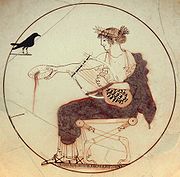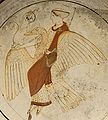
Pistoxenos Painter
Encyclopedia


Ancient Greece
Ancient Greece is a civilization belonging to a period of Greek history that lasted from the Archaic period of the 8th to 6th centuries BC to the end of antiquity. Immediately following this period was the beginning of the Early Middle Ages and the Byzantine era. Included in Ancient Greece is the...
vase painter of the Classical period
Classical Greece
Classical Greece was a 200 year period in Greek culture lasting from the 5th through 4th centuries BC. This classical period had a powerful influence on the Roman Empire and greatly influenced the foundation of Western civilizations. Much of modern Western politics, artistic thought, such as...
. He was active in Athens
Athens
Athens , is the capital and largest city of Greece. Athens dominates the Attica region and is one of the world's oldest cities, as its recorded history spans around 3,400 years. Classical Athens was a powerful city-state...
between circa 480 and 460 BC. His conventional name is derived from his name vase
Name vase
In classical archaeology, a name vase is a specific "vase" whose painter's name is unknown but whose workshop style has been identified. The painter is conventionally named after the selected "name vase" that embodies his characteristic style, or for one of its distinctive painted subjects, or for...
. The vase, a skyphos
Skyphos
In classifying the pottery of Ancient Greece, a skyphos is a two-handled deep wine-cup on a low flanged base or none. The handles may be horizontal ear-shaped thumbholds that project from the rim , or they may be loop handles at the rim or that stand away from the lower part of the body...
, now at Schwerin
Schwerin
Schwerin is the capital and second-largest city of the northern German state of Mecklenburg-Vorpommern. The population, as of end of 2009, was 95,041.-History:...
, has a signature indicating that it was made by the potter Pistoxenos. It depicts Iphikles
Iphicles
In Greek mythology, Iphicles is the name of three different people:*The half-brother of Heracles, being the son of Alcmene and her human husband Amphitryon, whereas Heracles was her son by Zeus. Iphicles was the father of Heracles' charioteer Iolaus by Automedusa, daughter of Alcathous...
being taught music by Linos, and Heracles
Heracles
Heracles ,born Alcaeus or Alcides , was a divine hero in Greek mythology, the son of Zeus and Alcmene, foster son of Amphitryon and great-grandson of Perseus...
accompanied by his tattooed Thracian
Thracians
The ancient Thracians were a group of Indo-European tribes inhabiting areas including Thrace in Southeastern Europe. They spoke the Thracian language – a scarcely attested branch of the Indo-European language family...
servant Geropso. The Pistoxenos Painter probably started his apprenticeship with the Antiphon Painter
Antiphon Painter
The Antiphon painter was an Athenian vase painter of the early 5th century BC. He owes his name to a double Kalos inscription of Antiphon on the dinos stand in the Antique collection of Berlin . He was active between 500 and 475 BC in Athens as a painter of the red figure style in the largest...
in the workshop of Euphronios
Euphronios
Euphronios was an ancient Greek vase painter and potter, active in Athens in the late 6th and early 5th centuries BC. As part of the so-called "Pioneer Group,"...
. He specialized in kylikes
Kylix (drinking cup)
A kylix is a type of wine-drinking glass with a broad relatively shallow body raised on a stem from a foot and usually with two horizontal handles disposed symmetrically...
, which he painted in the red-figure
Red-figure pottery
Red-figure vase painting is one of the most important styles of figural Greek vase painting. It developed in Athens around 530 BC and remained in use until the late 3rd century BC. It replaced the previously dominant style of Black-figure vase painting within a few decades...
style. Some of his best pieces, however, were produced in the White Ground Technique
White Ground Technique
White-ground technique is a style of ancient Greek vase painting in which figures appear on a white background. It developed in the region of Attica.-Technique and style:...
. The most important motifs of his paintings are horses, warriors and thiasos imagery. He was one of the first painters to employ four-colour polychromy, using slip
Slip (ceramics)
A slip is a suspension in water of clay and/or other materials used in the production of ceramic ware. Deflocculant, such as sodium silicate, can be added to the slip to disperse the raw material particles...
, paints and gilding. This style often resembles monumental painting. In his later works he grew so skillful that he could omit the "relief line". Stylistically, he is close to the Penthesilea Painter
Penthesilea Painter
The Penthesilea Painter was a Greek vase painter of the Attic red-figure style. His true name is unknown. His conventional name is derived from his name vase, "bowl 2688" in Munich, the inside of which depicts the slaying of Penthesilea by Achilles...
. His kalos inscriptions
Kalos inscription
The Kalos inscription was a form of epigraph found on Attic vases and graffiti in antiquity, common between 550 and 450 BC, and usually found on symposion vessels. The word καλός means "beautiful"; here it had an erotic connotation, and the inscription took the form of a youth's name, in the...
refer to the names Lysis, Glaukon and Megakles.

